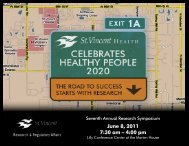Making Data Talk: A Workbook - National Cancer Institute
Making Data Talk: A Workbook - National Cancer Institute
Making Data Talk: A Workbook - National Cancer Institute
- No tags were found...
Create successful ePaper yourself
Turn your PDF publications into a flip-book with our unique Google optimized e-Paper software.
Use strategies to overcome tendencies and biasesHealth communicators can use a variety of factors about their audiences, from the characteristics discussed inChapter 2 of this workbook to the quantitative literacy level, general tendencies, and mental shortcuts discussedin this chapter. Below are several tips that take these factors into consideration and can improve communicationabout public health data across a wide spectrum of groups:Determine whether data should be presented. Are there sufficient data to support a science-basedstoryline? If so, are they appropriate for presentation to intended audiences?Be brief and concise. Present the “bottom line” and use only a few data points to support it.Be complete and transparent in portraying statistics. Word choice, as well as the selection or omissionof data, can be highly influential in how audiences receive and interpret data. Avoid implication of a causal linkbetween variables that are only associated through correlation.Identify and counter mistaken health-related lay audience beliefs. Use messages that acknowledge themisconception, diplomatically state why it is inaccurate, and present an alternate explanation.Use familiar types of data and explain key scientific or mathematical concepts. Choose formats thatwill likely be familiar (e.g., frequencies and round numbers) and supplement data that has the potential to bemisunderstood (e.g., concepts of risk) with explanations or additional materials as needed.Address uncertainty directly. Be honest about the tentative nature of the science, emphasize why scientistscannot make a definitive explanation, and work to answer questions about what uncertainty means for people.Ensure usability. Select user-friendly formats (e.g., boxes that highlight key points, upfront summaries ofinformation) so that audiences can process information more accurately and efficiently.Provide contextual information. Present individual findings within their larger context, using tools such ascomparison data and short text phrases that state the key findings as appropriate.After reading this chapter, you should be more familiar with factors that can influence how people receive andinterpret data. For further detail on concepts presented in this chapter, refer to Chapter 3, Overcoming GeneralAudience Tendencies and Biases to Enhance Lay Understanding of <strong>Data</strong>, of <strong>Making</strong> <strong>Data</strong> <strong>Talk</strong>: CommunicatingPublic Health <strong>Data</strong> to the Public, Policy Makers, and the Press.13





